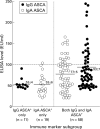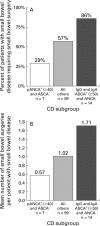Marker antibody expression stratifies Crohn's disease into immunologically homogeneous subgroups with distinct clinical characteristics
- PMID: 10986208
- PMCID: PMC1728065
- DOI: 10.1136/gut.47.4.487
Marker antibody expression stratifies Crohn's disease into immunologically homogeneous subgroups with distinct clinical characteristics
Abstract
Background: Perinuclear antineutrophil cytoplasmic antibodies (pANCA) have been detected in a clinically distinct Crohn's disease subpopulation. Antibodies to Saccharomyces cerevisiae (ASCA) have been demonstrated in the majority of patients with Crohn's disease.
Aims: To examine the relationship between selective marker antibody expression in Crohn's disease and disease onset, location, and clinical behaviour patterns.
Methods: Sera from 156 consecutive patients with established Crohn's disease were evaluated in a blinded fashion for the presence of ASCA and ANCA. Clinical profiles were generated by investigators blinded to immune marker status.
Results: Using multiple regression analyses, higher ASCA levels were shown to be independently associated with early age of disease onset as well as both fibrostenosing and internal penetrating disease behaviours. Higher ANCA levels were associated with later age of onset and ulcerative colitis-like behaviour. Substratification of the Crohn's disease population using selective ANCA and ASCA expression (high levels of a single marker antibody): (1) distinguished homogeneous subgroups that manifested similar disease location and behaviours; and (2) identified patients with more aggressive small bowel disease.
Conclusions: The findings suggest that by taking into account the magnitude of the host immune response, Crohn's disease can now be stratified on an immunological basis into more homogeneous clinically distinct subgroups, characterised by greater uniformity among anatomical distribution of disease and disease behaviour.
Figures



References
Publication types
MeSH terms
Substances
Grants and funding
LinkOut - more resources
Full Text Sources
Other Literature Sources
Medical
